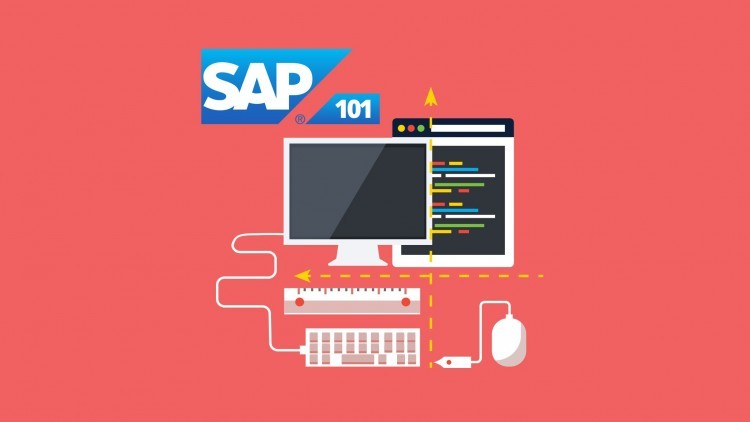SAP ERP: Become an SAP S/4HANA Certified Consultant - Pro
- Description
- Curriculum
- FAQ
- Reviews
>>> Updated at the beginning of 2020! <<<
Master an advanced skillset in the area of SAP business processes foundation to land 6-figure job (*based on Glassdoor statistics) with practical experience during real life examples.
This is a complete and comprehensive SAP Certified Associate – Business Process Integration with SAP S/4HANA and ERP 6.0 course. It is designed to prepare the student to be able to take and pass the certification exam needed to become certified.
The lectures are designed to be interactive, easily consumable through hands-on and demo-rich formats to give you the whole picture by putting the different function modules together.
SAP Enterprise Resource Planning is an industry-leading ERP system to help more than 80% of fortune 500 companies stay competitive by streamlining business processes, unlocking productivity and exploring insights.
I’m George, and I’ve been teaching people how to deploy, configure, and use SAP ERP since R/3 came into existence in 1990s.
If you are new to SAP, this course will help you get started, and for those of you who have been around SAP for some time this series can be used to help you expand your knowledge and prepare for the SAP S/4 certificate exam.
In this video series, I break SAP S/4 down for you. Each video is a self-contained discussion of a particular SAP module or feature, like finance, sales, reporting, deployment, analytics and more. And I’ve tried to be practical in these episodes, too. Each one contains explanations of the topic, and demonstrations for using it.
Topics included:
- S/4 HANA and ERP overview
- Fiori
- Sales and Distribution
- Production and Planning
- Materials Management
- Finance
- Human Capital Management
- Basis
- Embedded Analysis
- HANA database
- SAP Implementation
You will make your money back from the price of this course. Udemy guarantees it with their no-risk 30 day money back guarantee. You really have nothing to lose.
Thank you for signing up for this course on Udemy. The course will always be up-to-date here and nowhere else. I am also available for questions inside the course discussion board.
-
1WelcomeVideo lesson
The SAP ERP, or enterprise resource planning platform helps large businesses streamline their processes and support each segment of their business, from sales to financial accounting.
S/4HANA is the latest SAP business suites that’s been around since 2015. It continues to evolve, getting more and more powerful, while remaining stability and flexibility to use.
-
2What you should know before taking the courseVideo lesson
In order for you to get the best out of this course, it is very important that we set the expectations very early on. In this video, I'm going to walk you through some of the prerequisites of this course.
-
3Further readingText lesson
Subscribe to SAP public accounts to get latest news.
-
4A brief history of SAPVideo lesson
SAP was started in 1972 by five former IBM employees with a vision of creating a standard application software for real-time business processing. SAP stands for Systems Applications and Products in Data Processing.
-
5Understand the key aspects of SAP Business SuiteVideo lesson
SAP Business Suite software, a set of fully integrated applications such as SAP ERP, SAP CRM, SAP SCM, and SAP SRM, enables enterprises to run their core business operations more efficiently. It provides end-to-end process support for areas such as customer engagement, finance, human resources, manufacturing, procurement, logistics and IT.
-
6Understand the key aspects of SAP S/4 HANAVideo lesson
SAP's ERP is a suite of integrated modules used to collect, transact and report on data from their business activities. It enables the flow of information between the different parts of a company and with outside stakeholders, like customers and vendors.
SAP S/4HANA is SAP's ERP for large enterprises. It is the successor of SAP R/3 and SAP ERP and is optimized for SAP's in-memory database SAP HANA.
-
7Benefits and limitations of using SAPVideo lesson
There are many benefits and limitations of using SAP. Reasons for and against implementing SAP at an organization could fill an entire course. That said, let's review the top benefits and limitations.
-
8Build business case for SAP S/4HANAVideo lesson
From the perspective of business cases, which approach that is appropriate for your organization really is a very unique case by case situation where it's really looking at the degree of change, and it is a risk management exercise.
-
9Introduce the demo company of this courseVideo lesson
To help you better understand the business operations, I've modeled a demo company called - Orange.
-
10Quiz 1Quiz
Which database is SAP’s product?
-
11Quiz 2Quiz
Which systems comprise SAP’s Business Suite?
-
12Quiz 3Quiz
What is not the trend of driving the need for a re-engineered business suite built for the digital?
-
13Further readingText lesson
Broaden your knowledge about this section.
-
14Create a logon systemVideo lesson
In this demo, we will create a logon system.
-
15Log on to SAP GUIVideo lesson
In this demo, we will logon to SAP system via GUI
-
16Work with different toolbarsVideo lesson
In this demo, we will work with different types of toolbars
-
17Add a new item to favoritesVideo lesson
We will add a new shortcut to favorites menu in SAP GUI
-
18Work with SAP command fieldVideo lesson
In this demo, I will introduce the tips and tricks for the SAP transaction field
-
19Work with SAP HelpVideo lesson
In this demo, we will learn how to use SAP help
-
20Personalize your own dataVideo lesson
-
21Bonus: Navigate in the latest SAP GUI (Version 750)Video lesson
In this demo, we will walk you through the latest version of SAP GUI
-
22Create your solution instance with SAP CALText lesson
In this lecture, I will show you how-to: (1) access the SAP solution library within SAP CAL and (2) activate and create your SAP solution instance by explaining each step in the workflow.
-
23Quiz 1Quiz
-
24Quiz 2Quiz
-
25Quiz 3Quiz
-
26Further readingText lesson
In this lecture, you will learn more SAP GUI tips.
-
27Understand SAP FioriVideo lesson
Fiori is SAP's new browser-based user interface, so the idea is that you don't log in to your old, regular ERP system with the SAP GUI anymore. Instead, you use Fiori through a web browser.
-
28Fiori apps reference libraryVideo lesson
So here we are in the actual live Fiori apps library, and as we discussed in the previous module
-
29Generate Fiori apps recommendations reportVideo lesson
The primary goal of the Fiori App recommendations function is to identify Fiori Apps that best fit your needs, based on the profile from your systems.
-
30How to navigate SAP Fiori launchpadVideo lesson
In this demo, we will learn how to navigate SAP Fiori launchpad
-
31Quiz 1Quiz
-
32Quiz 2Quiz
-
33Quiz 3Quiz
-
34Further readingText lesson
In this lecture, you will broaden your knowledge about SAP Fiori.
-
35Understand organizational unit, element, structureVideo lesson
Elements of the SAP System logical structure, important for Financial Accounting .
Organizational units are used to structure business functions and for reporting. The organizational units of Financial Accounting are used for external reporting purposes, that is, they fulfill requirements that your business is subject to from external parties, for example, legal regulations. The financial statements for example, are created based on the organizational units of Financial Accounting.
Basic settings in Financial Accounting are Customizing settings that you have to make in order to be able to carry out processes in Financial Accounting .
-
36Explore master dataVideo lesson
SAP R/3 works on real-time data, i.e., there is no time lag between data entry and data availability. The important thing while creating any data is to maintain data integrity. SAP R/3 data is categorized into two −
Master data − Data that is created centrally, and is valid for all applications. It remains constant over time but we need to update it on a regular basis. For example: Vendor is a type of master data that is used for creating purchase orders or contracts.
Transactional data − Data that is associated with processing of business transaction is transactional data.
SAP Master Data is of the following two types −
Material Master Data
Vendor Master Data
-
37Display a material master record via Fiori LaunchpadVideo lesson
In this demo, we will learn how to display a material master record
-
38Display a customer master data via Fiori LaunchpadVideo lesson
-
39Display a customer master data via GUIVideo lesson
In this demo, we will learn how to display a customer master data
-
40Display a business partner via Fiori LaunchpadVideo lesson
In this demo, we will learn how to display a business partner
-
41Quiz 1Quiz
-
42Quiz 2Quiz
-
43Quiz 3Quiz
-
44Further readingText lesson
In this lecture, you will broaden your knowledge about SAP organizational structure.
-
45Understand the different modules in SAP ERPVideo lesson
There are 2 Types of SAP ERP system Modules. Number one is Functional Modules and second one is Technical Modules. All SAP Modules integrated with each other with functionality and provide us best solution for Business. Most important SAP Modules that Bunnies implement for their business are
Functional modules:
SAP FICO module
MM Module
SD module
HR module
PP module
PS module
Technical modules:
Basis module
security module
ABAP module
-
46Introduce Enterprise ManagementVideo lesson
SAP S/4HANA Enterprise Management represents the foundational core that covers all mission-critical business processes of an enterprise. It is built on SAP HANA, designed with the SAP Fiori user experience, and delivered in the cloud and on premise.
-
47How enterprise management worksVideo lesson
In this lecture, we will learn how logistics works from the perspective of business processes
-
48Sales and Distribution | SDVideo lesson
SAP Sales and Distribution (SD) is an important module of SAP ERP consisting of business processes required in selling, shipping, billing of a product. The module is tightly integrated with SAP MM & SAP PP. Key sub-modules of SAP SD are Customer and Vendor Master Data, Sales, Delivery, Billing, Pricing, and Credit Management.
-
49Business processes in SDVideo lesson
The sales documents you create are individual documents but they can also form part of a chain of inter-related documents. For example, you may record a customers telephone inquiry in the system. The customer next requests a quotation, which you then create by referring to the inquiry. The customer later places an order on the basis of the quotation and you create a sales order with reference to the quotation. You ship the goods and bill the customer. After delivery of the goods, the customer claims credit for some damaged goods and you create a free-of-charge delivery with reference to the sales order. The entire chain of documents the inquiry, the quotation, the sales order, the delivery, the invoice, and the subsequent delivery free of charge creates a document flow or history. The flow of data from one document into another reduces manual activity and makes problem resolution easier. Inquiry and quotation management in the Sales Information System help you to plan and control your sales.
-
50Create a sales order via Fiori LaunchpadVideo lesson
-
51Create a sales order via GUIVideo lesson
In this demo, we will create a sales order
-
52Create a delivery and post a goods issue via Fiori LaunchpadVideo lesson
-
53Create a delivery and post a goods issue via GUIVideo lesson
In this demo, we will create a delivery and post a goods issue
-
54Create a sales order billing document via Fiori LaunchpadVideo lesson
-
55Create a sales order billing document via GUIVideo lesson
In this demo, we will create a sales order billing document
-
56Materials Management | MMVideo lesson
SAP MM is the short form for SAP Material Management system. The roles of SAP MM in a business process are as follows −
A business process in SAP is termed as a “module”.
SAP MM is a part of logistics functions and it helps in managing the procurement activities of an organization.
It supports all aspects of material management (planning, control, etc.).
It is the backbone of logistics that incorporates modules such as Sales and Distribution, Production Planning, Plant Maintenance, Project Systems, and Warehouse Management.
-
57Business processes in ProcurementVideo lesson
In this lecture, we will explain the business processes in procurement (sub module of material management)
-
58Business processes in inventory managementVideo lesson
In this lecture, we will learn the business processes in inventory management (sub-module of material management)
-
59Create a purchase order for a stock material via Fiori LaunchpadVideo lesson
-
60Create a purchase order for a stock material via GUIVideo lesson
In this demo, we will create a purchase order for a stock material
-
61Create a goods receipt by referencing a purchase order via Fiori LaunchpadVideo lesson
-
62Create a goods receipt by referencing a purchase order via GUIVideo lesson
In this demo, we will create a goods receipt by referencing a purchase order
-
63Verify a logistic invoice via Fiori LaunchpadVideo lesson
-
64Verify a logistic invoice via GUIVideo lesson
In this demo, we will verify logistics invoice
-
65Production Planning | PPVideo lesson
SAP PP (Production Planning) Training. SAP PP is one the important module in SAP system. It handles all business process related to production of a company. In SAP R/3 system modular data is classified as master data and transaction data where the master data is defined as the individual module objects.
-
66Business processes in PlanningVideo lesson
In this lecture, we will understand business processes in planning
-
67Business processes in ProductionVideo lesson
In this lecture, we will understand business processes in production
-
68Create Planned Independent Requirements (PIRs) via Fiori LaunchpadVideo lesson
-
69Display a bill of materials (BOM) via Fiori LaunchpadVideo lesson
-
70Display a bill of materials (BOM) via GUIVideo lesson
In this demo, we will display a bill of materials (BOM)
-
71Display a routing via Fiori LaunchpadVideo lesson
-
72Execute the MRP Live Planning Run via Fiori LaunchpadVideo lesson
-
73Display a stock requirements list via Fiori LaunchpadVideo lesson
-
74Display a stock requirements list via GUIVideo lesson
In this demo, we will display a stock requirements list
-
75Create a production order via Fiori LaunchpadVideo lesson
-
76Create a production order via GUIVideo lesson
In this demo, we will create a production order
-
77Confirm a production order via Fiori LaunchpadVideo lesson
-
78Confirm a production order via GUIVideo lesson
In this demo, we will confirm a production order
-
79Quiz 1Quiz
-
80Quiz 2Quiz
-
81Quiz 3Quiz
-
82Quiz 4Quiz
-
83Quiz 5Quiz
-
84Quiz 6Quiz
-
85Most frequently used t-codes in enterprise management (previously logistics)Text lesson
In this lecture, you will learn most frequently used t-codes in enterprise management (previously logistics) to work as an end users and consultants.
-
86Further readingText lesson
In this lecture, you will broaden your knowledge about Enterprise Management (previously logistics).

External Links May Contain Affiliate Links read more





